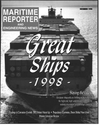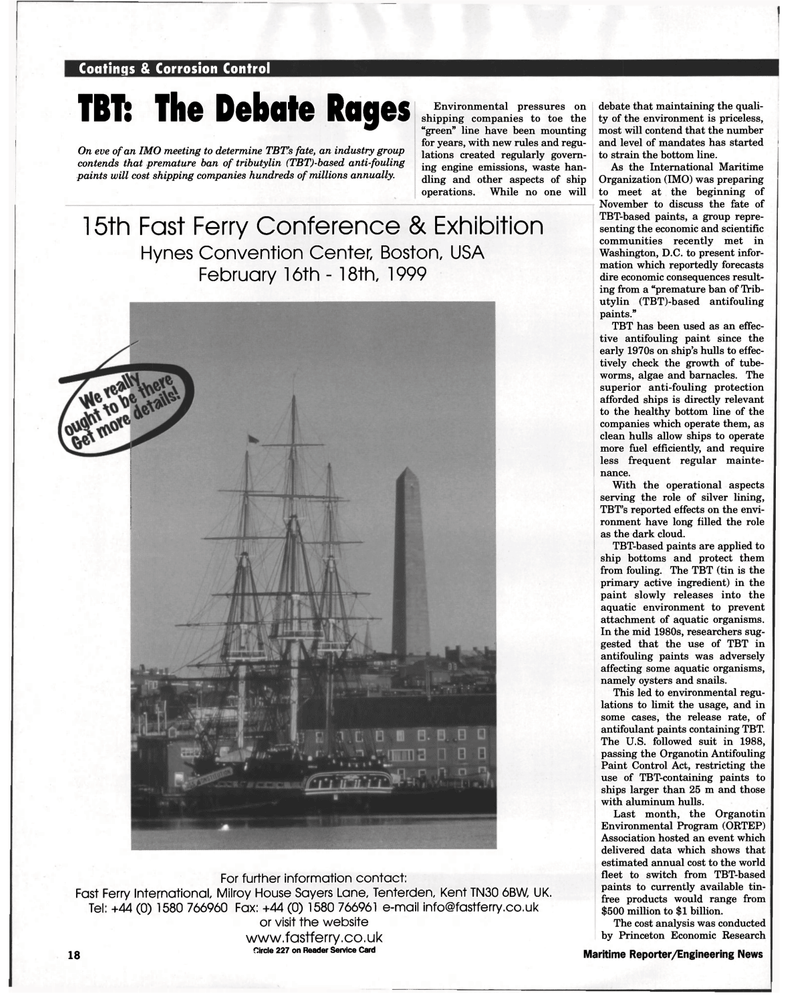
Page 18: of Maritime Reporter Magazine (December 1998)
Read this page in Pdf, Flash or Html5 edition of December 1998 Maritime Reporter Magazine
Coatings & Corrosion Control
TBI: The Debate Rages
On eve of an IMO meeting to determine TBT's fate, an industry group contends that premature ban of tributylin (TBT)-based anti-fouling paints will cost shipping companies hundreds of millions annually.
Environmental pressures on shipping companies to toe the "green" line have been mounting for years, with new rules and regu- lations created regularly govern- ing engine emissions, waste han- dling and other aspects of ship operations. While no one will 15th Fast Ferry Conference & Exhibition
Hynes Convention Center, Boston, USA
February 16th - 18th, 1999
For further information contact:
Fast Ferry International Milroy House Sayers Lane, Tenterden, Kent TN30 6BW, UK.
Tel: +44 (0) 1580 766960 Fax: +44 (0) 1580 766961 e-mail [email protected] or visit the website www.fastferry.co.uk 18 Circle 227 on Reader Service Card debate that maintaining the quali- ty of the environment is priceless, most will contend that the number and level of mandates has started to strain the bottom line.
As the International Maritime
Organization (IMO) was preparing to meet at the beginning of
November to discuss the fate of
TBT-based paints, a group repre- senting the economic and scientific communities recently met in
Washington, D.C. to present infor- mation which reportedly forecasts dire economic consequences result- ing from a "premature ban of Trib- utylin (TBT)-based antifouling paints."
TBT has been used as an effec- tive antifouling paint since the early 1970s on ship's hulls to effec- tively check the growth of tube- worms, algae and barnacles. The superior anti-fouling protection afforded ships is directly relevant to the healthy bottom line of the companies which operate them, as clean hulls allow ships to operate more fuel efficiently, and require less frequent regular mainte- nance.
With the operational aspects serving the role of silver lining,
TBT's reported effects on the envi- ronment have long filled the role as the dark cloud.
TBT-based paints are applied to ship bottoms and protect them from fouling. The TBT (tin is the primary active ingredient) in the paint slowly releases into the aquatic environment to prevent attachment of aquatic organisms.
In the mid 1980s, researchers sug- gested that the use of TBT in antifouling paints was adversely affecting some aquatic organisms, namely oysters and snails.
This led to environmental regu- lations to limit the usage, and in some cases, the release rate, of antifoulant paints containing TBT.
The U.S. followed suit in 1988, passing the Organotin Antifouling
Paint Control Act, restricting the use of TBT-containing paints to ships larger than 25 m and those with aluminum hulls.
Last month, the Organotin
Environmental Program (ORTEP)
Association hosted an event which delivered data which shows that estimated annual cost to the world fleet to switch from TBT-based paints to currently available tin- free products would range from $500 million to $1 billion.
The cost analysis was conducted by Princeton Economic Research
Maritime Reporter/Engineering News

 17
17

 19
19
